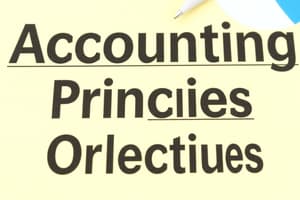Podcast
Questions and Answers
Which of these is considered a non-financial objective an entrepreneur may have?
Which of these is considered a non-financial objective an entrepreneur may have?
- Reducing variable costs
- Increasing market share
- Maximizing profit margin
- Achieving personal satisfaction (correct)
Fixed costs change depending on the number of products sold.
Fixed costs change depending on the number of products sold.
False (B)
What is the term for the point where a business' revenue matches its total costs?
What is the term for the point where a business' revenue matches its total costs?
break-even point
The amount of money a business keeps, rather than paying out to shareholders, is called ______.
The amount of money a business keeps, rather than paying out to shareholders, is called ______.
Match the following terms with their definitions:
Match the following terms with their definitions:
What is the formula for calculating Total Costs?
What is the formula for calculating Total Costs?
A business with a positive cash flow has less money coming in than going out.
A business with a positive cash flow has less money coming in than going out.
What is the term for costs directly involved in production?
What is the term for costs directly involved in production?
The income a business receives from sales is called ______.
The income a business receives from sales is called ______.
What does a negative cash flow indicate for a business?
What does a negative cash flow indicate for a business?
Flashcards
Revenue
Revenue
The income a business receives from sales. This is the total amount of money the business makes from selling its products or services.
Fixed Costs
Fixed Costs
Costs that do not change, regardless of how many products are sold. These are essential expenses that the business must pay, even if it sells nothing.
Variable Costs
Variable Costs
Costs that vary depending on the number of products sold. These costs directly depend on the production of each item.
Profit
Profit
Signup and view all the flashcards
Break-Even Point
Break-Even Point
Signup and view all the flashcards
Net Cash Flow
Net Cash Flow
Signup and view all the flashcards
Overdraft
Overdraft
Signup and view all the flashcards
Credit
Credit
Signup and view all the flashcards
Retained Profit
Retained Profit
Signup and view all the flashcards
Share Capital
Share Capital
Signup and view all the flashcards
Study Notes
1.3 Business Aims & Objectives
- Market Share: The proportion of sales in a market taken by one business.
- Profit: The amount of revenue left over after deducting costs.
- Social Objective: Likely to be non-financial, such as reducing carbon emissions or improving the quality of life for a local community.
- Financial Objectives: Targets expressed in money terms, like profit, building wealth, or survival.
- Non-Financial Objectives: Personal objectives of entrepreneurs, such as personal satisfaction, challenge, or independence.
1.3B Business Revenues, Costs & Profits
- Revenue: The income a business receives from sales.
- Income Stream: The source of regular income for a business.
- Viable: Capable of succeeding.
- Fixed Costs: Do not change regardless of production volume.
- Variable Costs: Change depending on production volume.
- Total Costs: Fixed costs plus variable costs.
- Income Statement: A financial statement showing income and expenses over a period, resulting in profit or loss.
- Stakeholder: Anyone with an interest in a business's activities.
- Cost of Sales: Costs directly involved in production (e.g., stock).
- Expenses: Costs indirectly involved in production (e.g., electricity, salaries).
- Break-Even Point: The point where a business's revenue matches its total costs.
- Margin of Safety: The amount sales can fall before reaching the break-even point.
1.3C Cash & Cash Flow
- Cash Flow: The way money flows into and out of a business.
- Positive Cash Flow: More money coming in than going out.
- Negative Cash Flow: Less money coming in than going out.
- Credit: The amount of money a financial institution or supplier allows a business to use, which the business must repay later.
- Overheads: Fixed costs related to running an office, shop, or factory.
- Insolvent: A business unable to pay its debts.
- Consumables: Items used up regularly (e.g., pens, paper).
- Cash Inflows: Money entering the business.
- Cash Outflows: Money leaving the business.
- Net Cash Flow: The difference between inflows and outflows.
- Opening Balance: The amount of money in the bank at the start of a period.
- Closing Balance: The amount of money in the bank at the end of a period.
1.3D Sources of Business Finance
- Overdraft: A bank facility that allows borrowing money at short notice.
- Trade Credit: A credit arrangement offered by suppliers.
- Personal Savings: Money saved by the entrepreneur.
- Venture Capital: Money lent by large businesses to startups or entrepreneurs.
- Share Capital: Money invested in a business by shareholders.
- Loans: An amount of money lent with interest.
- Retained Profit: Money a business keeps rather than distributing to shareholders.
- Crowdfunding: Obtaining funds from a large number of people, each contributing a small amount.
1.3E Finance - Key Calculations
- Revenue: Price x Quantity Sold.
- Total Variable Costs: Variable cost x Quantity Sold.
- Total Costs: Fixed Costs + Total Variable Costs.
- Gross Profit: Sales Revenue - Cost of Sales.
- Net Profit: Gross Profit - Other Operating Expenses & Interest.
- Interest (%): (Total Repayment - Borrowed Amount) / Borrowed Amount x 100.
- Contribution: Price - Variable Costs.
- Break-Even Point: Fixed Costs / (Price - Variable Costs).
- Margin of Safety: Actual or Budgeted Sales - Break-Even Sales.
- Net Cash Flow: Cash Inflows - Cash Outflows.
Studying That Suits You
Use AI to generate personalized quizzes and flashcards to suit your learning preferences.




